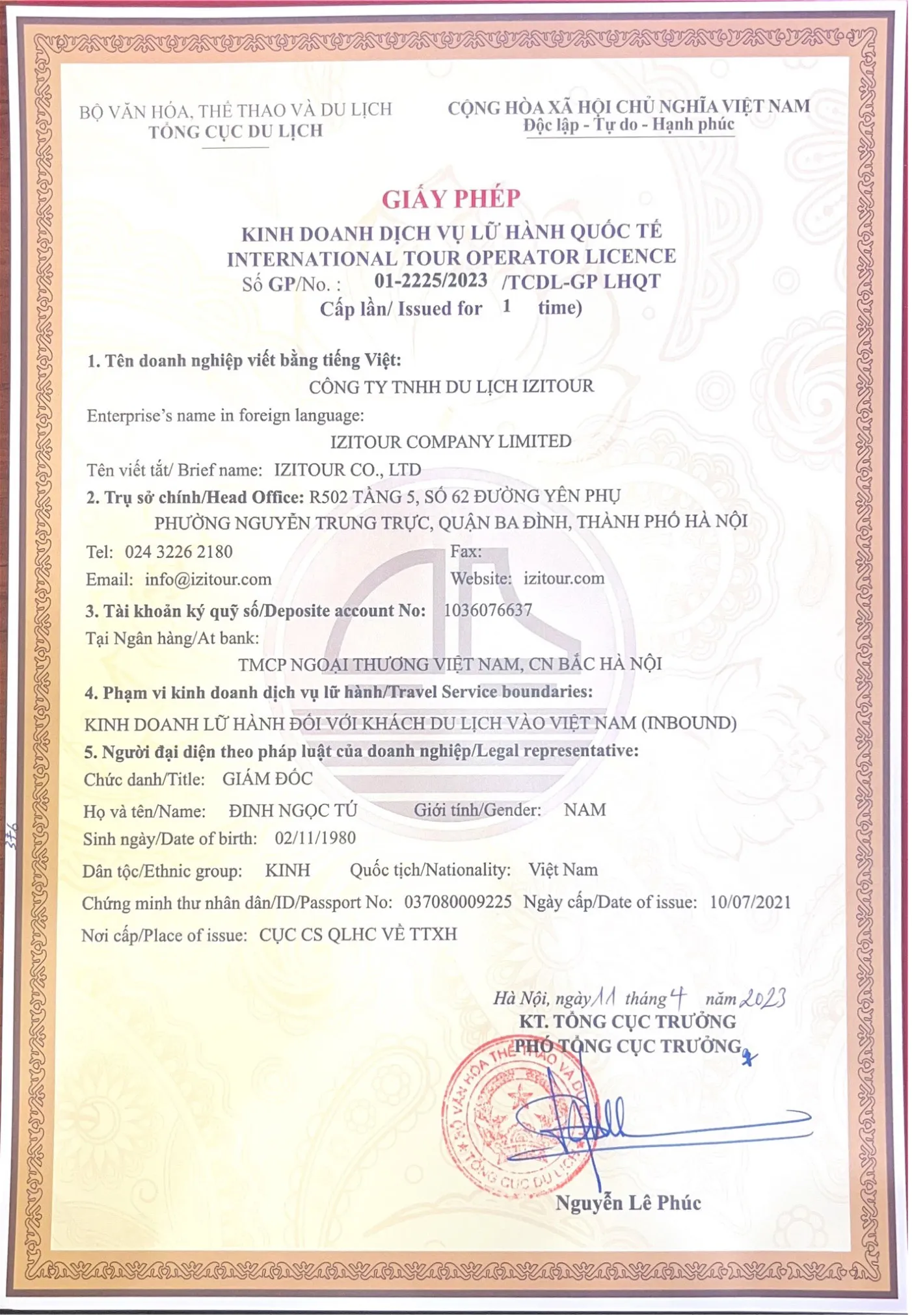Hoi An, literally meaning "peaceful meeting place," is a charming coastal town in central Vietnam. Since its recognition by UNESCO in 1999, the town has continued to captivate hearts and inspire souls. But what fascinates in Hoi An Ancient Town isn't merely its architecture or its titles of glory. It is a living heritage, a shared memory within ancient walls, the gestures of artisans, and the smiles of its inhabitants. It's the subtle sensations, that blend of beauty, gentleness, and vibrant silence that makes it a place apart.
- 1. Why does Hoi An Ancient Town fascinate travelers worldwide?
- 2. What to see in Hoi An Ancient Town?
- 3. What to do in Hoi An Ancient Town?
- Admire ancient architecture - travel through centuries
- Experience daily life at Hoi An market - amidst colors, scents, and smiles
- Participate in the Lantern Festival - the magic of full moon nights
- Taste the Hoi An cuisine - Vietnam in a bite
- Get custom clothing made - Vietnamese luxury
- Explore the countryside by bike or on foot - slowness and freedom
- Navigate a basket boat in Bay Mau coconut forest
- Visit craft villages - the soul of Hoi An in your hands
- Join activities in Tra Que Village - Immersion in local agricultural life
- Diving in Cu Lao Cham: A blue escape
- 4. When to visit Hoi An Vietnam?
- 5. Where to stay in Hoi An Ancient Town?
- 6. How to get to Hoi An Ancient Town?
- 7. Suggested itineraries to discover Hoi An
- FAQs about Hoi An Vietnam
- How many nights should you stay in Hoi An Ancient Town?
- Do you need to buy a ticket to visit the Ancient Town?
- Where to stay during a combined Da Nang - Hue - Hoi An tour?
- Can you rent a motorbike from Hue to Hoi An Ancient Town?
- Can you visit Ba Na Hills from Hoi An?
- How to get from Hoi An to Phong Nha?
1. Why does Hoi An Ancient Town fascinate travelers worldwide?
It's no coincidence that Travel + Leisure voted Hoi An the "best city in the world", ahead of Tokyo or Rome. Nor that CNN described it as one of Southeast Asia's most beautiful ancient cities, highlighting its status as a historic trading hub, marked by French, Chinese, and Japanese influences.
But more than titles or rankings, it's the emotions left in the hearts of travelers that say it all. We return to Hoi An not to see more, but to feel again. Because here, everylantern tells a story. Every silence has a scent. And every morning has something eternal about it.
A city born from the meeting of cultures
Hoi An is the rare fruit of a peaceful cross-cultural exchange between civilizations. A flourishing ancient trading port from the 15th century, the city saw Chinese, Japanese, Indian, and European merchants pass through. And each, over time, left a discreet but lasting imprint, elegantly integrated into Vietnamese identity. This wealth of cultures, far from fragmenting the city, unified it in an unprecedented harmony. Chinese temples stand alongside Vietnamese wooden houses, Japanese bridges span canals, and symbols echo each other. Everything here is a dialogue - silent but profound.
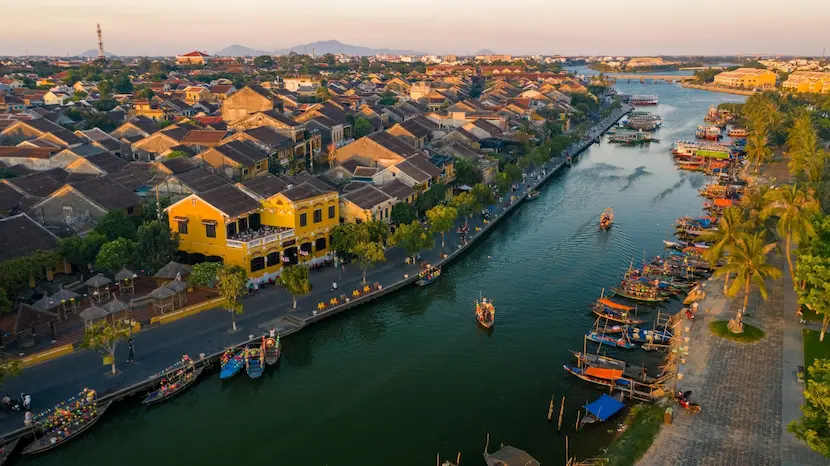
Ancient architecture, still inhabited
Hoi An captivates with the intact grace of its architecture, but even more so by the fact that this architecture continues to live. These are not static décors: they are open, inhabited houses, permeated by the gestures of daily life. Here, the past is not frozen in a display case. It naturally invites itself into the present, without ever overshadowing modernity. A cafe opens in an ancient merchant house; an art gallery settles behind a lacquered gate. And all of this happens seamlessly.
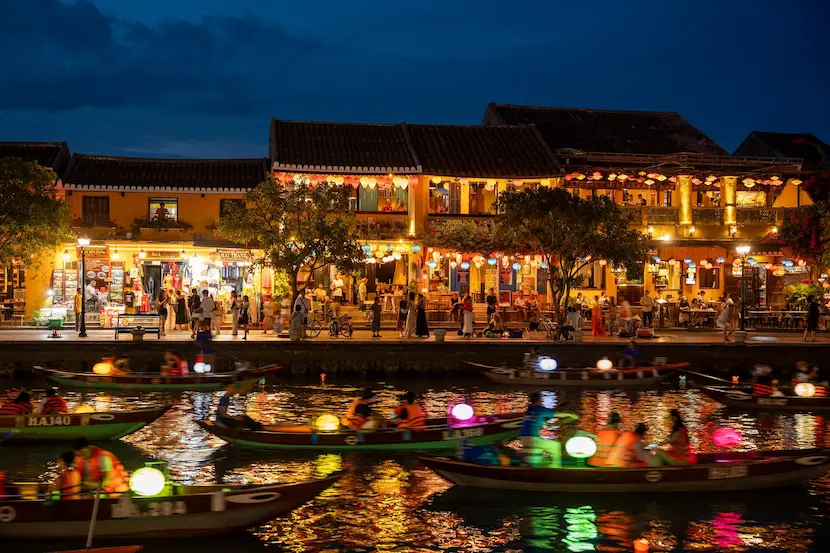
A unique atmosphere, woven by the people
What lingers isn't what you see. It's what you feel. Hoi An captivates as much by its landscapes as by its atmosphere, its way of being, of speaking, of receiving. The inhabitants don't welcome you as passing guests, but as if they already knew you - with kindness and discretion. The city is neither noisy nor cold.
"Visitors sometimes come once, sometimes twice... but why do they come back again and again? Because behind the walls is the soul of the city - embodied by the people of Hoi An. They know how to create a warm connection, without ever being intrusive or overly familiar. This is undoubtedly a trait inherited from the days of the ancient trading ports. Even the space here is quiet without being mute. And the inhabitants have managed to sell this tranquility to make it their wealth", confided by a local.
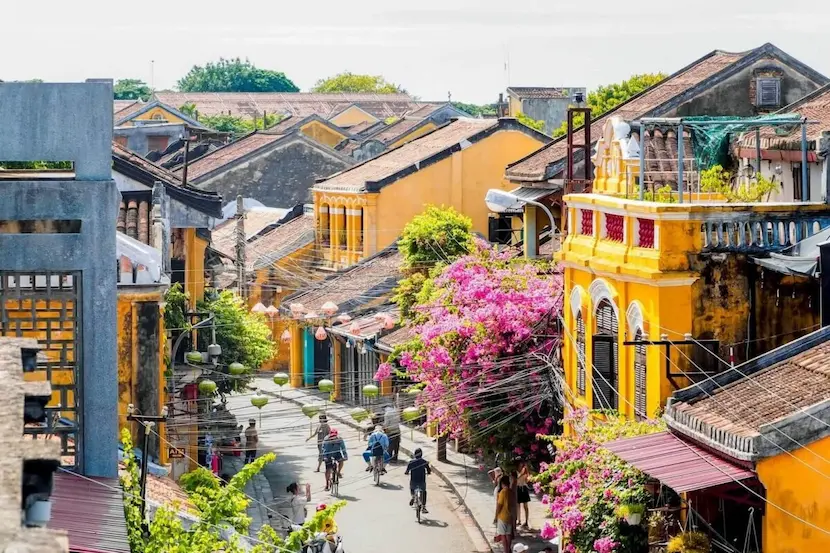
2. What to see in Hoi An Ancient Town?
A UNESCO World Heritage site, Hoi An Ancient Town captivates at first glance. It resembles a delicate watercolor painting, where ancient houses with yellow facades follow one another in perfect poetic alignment. Here, everything seems frozen in time, yet at the same time vibrant with emotions: the soft sounds of footsteps on the cobblestones, the lanterns swaying in the wind, the incense slowly rising from the pagodas. Strolling through the Old Town means entering a different rhythm: that of silence, slowness, and lingering gazes. Early morning or evening after sunset are the best times to get lost without crowds and discover its secrets in the intimacy of deserted alleys.
Japanese Bridge (Chua Cau) - between two worlds
In the heart of the old quarter is a bridge so discreet you might miss it... but which alone symbolizes the entire history of Hoi An. Built by Japanese merchants in the 17th century, Chua Cau, a covered wooden bridge with an curved tiled roof, connects two banks of the same district - but more importantly, two cultures, two histories. You enter it like a sanctuary, to slow down, observe the details, and feel the wood polished by centuries. The best time to cross it is in the late afternoon, when the light turns golden and the lanterns gently light up. The bridge then becomes not a place of passage, but a place of pause.
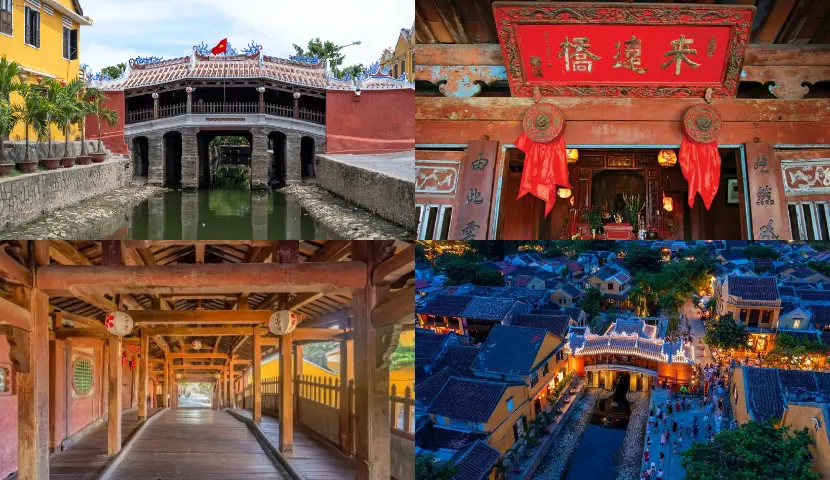
Ancient Houses and Assembly Halls - living memory
Hoi An was once a flourishing trading port. From that era, it has preserved merchant houses over two centuries old. Entering the Tan Ky House or the Phung Hung House is to touch the memory of merchant families up close. You see the black walls polished by time, lacquered wooden furniture, and everyday objects frozen in their original settings. Chinese congregational halls like Phuc Kien or Trieu Chau are true community temples. You can still feel the collective, social, and spiritual role of these places: roofs covered with dragons, richly decorated altars, incense burning in spirals in the still air.
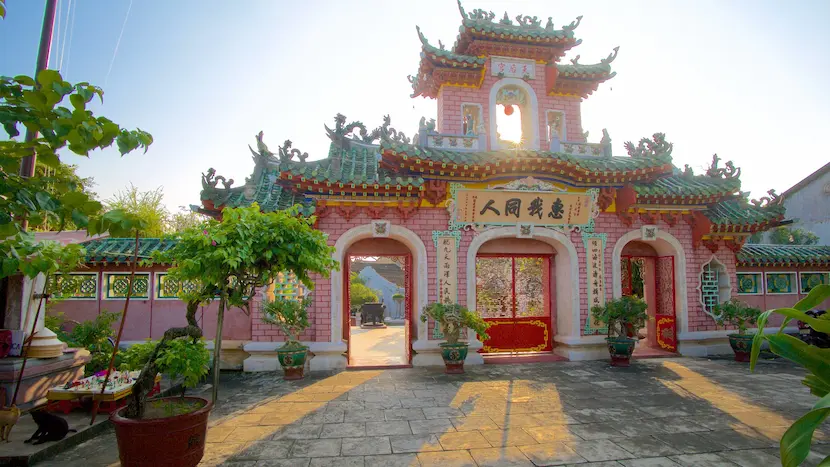
Hoi An Markets - explosion of colors and scents
Hoi An market never truly sleeps. From dawn, it vibrates to the rhythm of voices, scales, and bamboo baskets. You'll find fresh herbs, wiggling fish, silk rolls, multicolored lanterns... but above all, you'll feel real life. That of women joking between sales, children playing by the stalls, scents that tell stories better than words. And when night falls, the market transforms. It gently illuminates, street food stalls open, and lanterns shine above plastic tablecloths. From morning to evening, it's a lively, colorful, pulsating theater.

Hoi An Rice Fields - countryside just steps from the center
Just outside the Ancient Town, the scenery changes. Yellow houses give way to green expanses, shimmering rice fields, and narrow paths lined with bamboo. Here, time flows differently. More slowly... More gently. Unlike the spectacular terraced rice fields of the North, clinging to mountainsides and shaped by ethnic minorities, Hoi An's rice fields spread out flat, flush with the horizon, in perfect harmony with the gentleness of central Vietnam's countryside.
Cham Island (Cu Lao Cham) - wild island at the gates of Hoi An
Off the coast of Hoi An, the Cu Lao Cham archipelago appears as a promise of elsewhere. Accessible by speed boat from Cua Dai port, it offers peaceful beaches, fishing villages, and above all, astonishingly rich underwater life. A morning of snorkeling or diving is enough to discover colorful corals and schools of tropical fish. After a seafood lunch on the sand, you return to Hoi An with the taste of salt on your lips and a slightly lighter soul.
3. What to do in Hoi An Ancient Town?
Hoi An isn't just visited; it's experienced. Here, every activity seems inspired by the gentleness of time, the beauty of simple gestures, and the generosity of a people who welcome you as a guest, not a tourist. Here's a selection of must-do experiences in Hoi An Vietnam to immerse yourself in its soul.
Admire ancient architecture - travel through centuries
In Hoi An Ancient Town, architecture is a narrative. Every facade, every beam, every tile tells a story: that of Chinese merchants, Vietnamese families, Japanese and colonial influences that shaped this multicultural trading port. Push open the door of Tan Ky House or Phung Hung House, walk under the red trusses of Chinese assembly halls, cross the shaded and sunlit interior courtyards... you'll see that the walls here have memories.
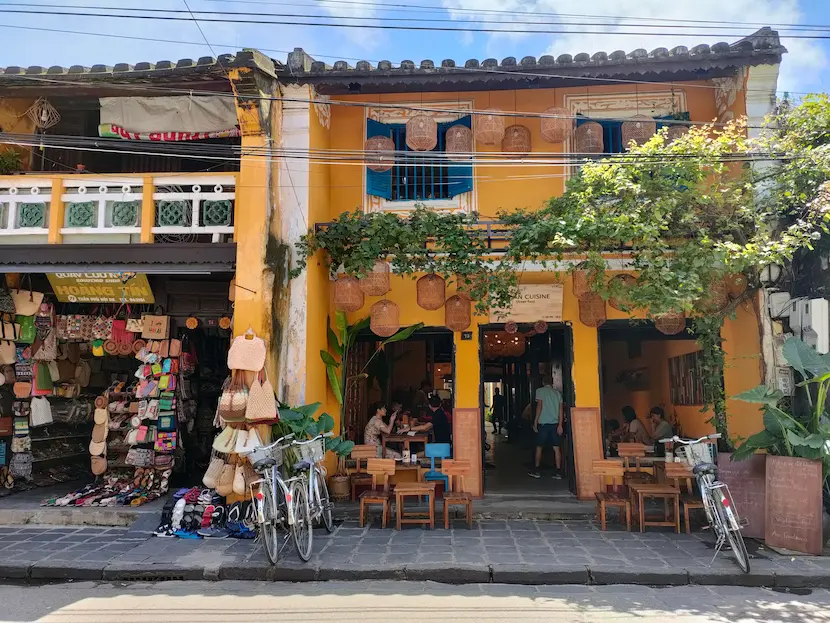
Experience daily life at Hoi An market - amidst colors, scents, and smiles
From dawn, the central market comes alive in a symphony of voices, smells, and textures. You'll find fresh herbs, still-wiggling fish, silk rolls, colorful lanterns, and a thousand busy but smiling faces. Strolling here is to taste the beating heart of the city, where traditions, cuisine, and authentic life blend.
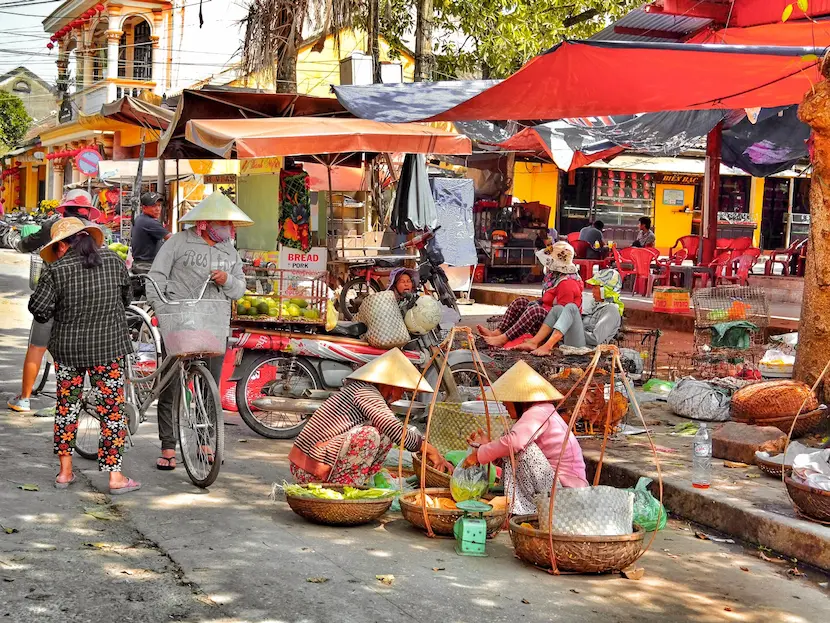
Participate in the Lantern Festival - the magic of full moon nights
Every lunar month, the Ancient Town dims. Neon lights go silent, and lanterns take over. Suspended from balconies, aligned along streets, or gently floating on the river, they transform Hoi An into a living tableau, bathed in gold and silk. Footsteps slow, eyes sparkle, and silence becomes music. On the banks of the Thu Bon River, small floating paper lanterns are lit and released onto the water with a secret wish. Others embark on a wooden boat, gliding between shifting reflections, to the rhythm of lapping water and glows. It's a suspended, almost sacred moment, where you touch the simplest and deepest poetry.
Learn more: Hoi An Lantern Festival 2025

Taste the Hoi An cuisine - Vietnam in a bite
You could spend days discovering Hoi An solely through its palate. Every street offers a specialty, every dish a story. Cao Lau, an emblematic dish, is prepared with sacred well water and unique noodles. Banh Mi Hoi An, crispy and generous, is a perfect fusion of French bread and Asian flavors. Sit on a plastic stool, order without hesitation, and let yourself be surprised by the subtlety of the herbs, the lightness of the broths, the vibrancy of the condiments.

Get custom clothing made - Vietnamese luxury
In Hoi An, tailoring is an art as accessible as it is refined. Within 24 to 48 hours, you'll leave with a dress, shirt, or suit, tailored to your measurements, chosen from fabrics you've personally selected. It's not just an order; it's a meeting, a warm exchange, a shared creation. And most importantly, a memory you carry with you, lastingly.

Explore the countryside by bike or on foot - slowness and freedom
Around Hoi An stretch peaceful landscapes, where rice fields extend under the sky and dirt paths wind between palm trees. Hopping on a bicycle or walking along the trails means taking the time to see, to listen, to feel. You'll cross paths with a buffalo resting in the shade, children waving and laughing, women picking aromatic herbs. It's an immersion in rural Vietnam, real and tranquil.
Navigate a basket boat in Bay Mau coconut forest
A few kilometers from the center, the Bay Mau water coconut forest is a small world apart. Here, the boats are not classic sampans but curious round woven bamboo baskets, which rowers maneuver with surprising agility - sometimes even spinning to the rhythm of songs. You'll glide through canals lined with water palms, observe fishermen casting their nets, and learn techniques for picking leaves for local basketry. It's a journey that is at once fun, authentic, and exotic.

Visit craft villages - the soul of Hoi An in your hands
Around Hoi An, craft villages are the silent guardians of centuries-old traditions. In Thanh Ha ceramic village, clay is molded by hand; you feel the weight of gestures passed down from mother to daughter. In Kim Bong, woodcarvers bring dragons and lotuses to life under their chisels. And in Tra Que herb village, the earth speaks, through aromatic herbs cultivated using ancestral methods. Taking the time to go there is to honor humble but precious craftsmanship, and to leave with more than souvenirs: connections.
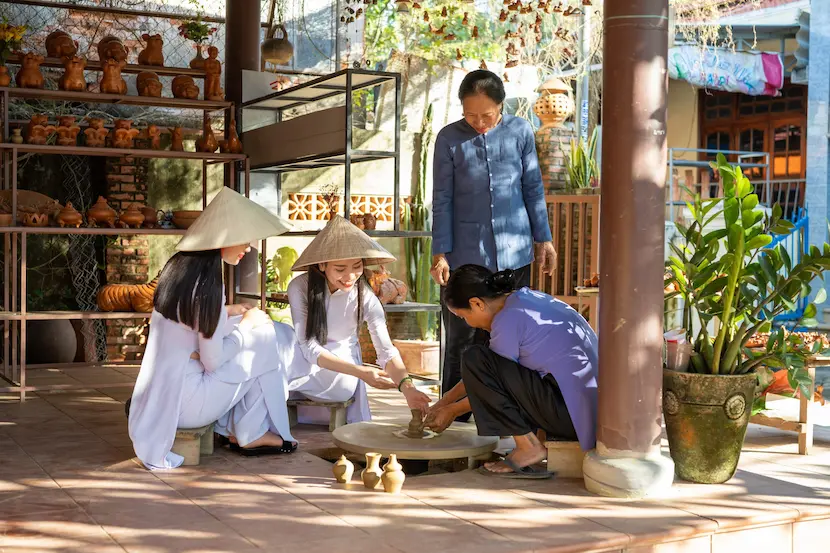
Join activities in Tra Que Village - Immersion in local agricultural life
Just a few minutes from the center of Hoi An, Tra Que village offers a serene escape into a lush green landscape. Here, visitors are invited to put on a conical hat, roll up their sleeves, and learn the techniques of the local farmers: tilling the soil, watering plants with traditional bamboo watering cans, or harvesting aromatic herbs grown without chemical fertilizers. This experience, both fun and enriching, provides a deeper understanding of the importance of organic farming in Vietnamese culture and allows for a simple, authentic moment shared with the locals. The visit often concludes with a cooking class or a friendly meal, prepared using fresh produce from the garden.

Diving in Cu Lao Cham: A blue escape
From Cua Dai port, a few kilometers from the Old Town, you embark on a quick crossing to Cham Island (Cu Lao Cham), a marine jewel off the coast of Hoi An. The water is crystal clear, the corals alive, the tropical fish abundant. A snorkeling or diving session allows you to explore these preserved depths with wonder. After the exploration, enjoy a seafood lunch on the beach, lulled by the sound of waves and the scent of seaweed. The return to Hoi An is light-hearted, hair still salty, and mind elsewhere.
Learn more: Diving and snorkeling in Hoi An - Spots and useful tips
4. When to visit Hoi An Vietnam?
Climate in Hoi An: 2 distinct seasons
Hoi An, located in central Vietnam, enjoys a tropical climate characterized by two main seasons:
- The dry season (February to August): hot temperatures, clear skies, moderate humidity.
- The rainy season (September to January): more frequent rainfall, high humidity, and sometimes risk of flooding in the Ancient Town (especially in October and November).
Unlike the North of the country, temperatures in Hoi An remain pleasant all year round (between 22°C and 35°C). What mainly changes is the level of rain and sunshine, which strongly influences the ambiance and possible activities.

Which period to choose based on your desires?
If you are looking for perfect weather, the months of February to May are ideal. The sky is clear, the air remains mild, and the heat is not yet overwhelming. This is the perfect time to stroll through the Ancient Town, cycle through the rice fields, or spend time at the beach without being bothered by heat or crowds. The light is magnificent for photography enthusiasts, and the surrounding nature, especially the rice fields, offers a vibrant and colorful spectacle.
If you love beaches and the sea, the period from June to August is the most suitable. The sun shines almost every day, the sea is calm, and nearby islands like Cu Lao Cham are easily accessible. You can go snorkeling, diving, or simply relax by the water. It's also the peak beach season in Hoi An, with a lively atmosphere, various water activities, and local life paced by summer tourism.
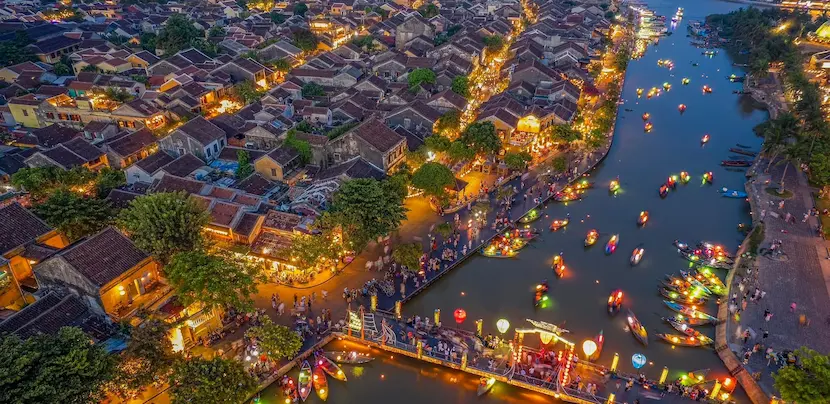
If you want to experience culture and festivals, certain dates deserve special attention. Every lunar month, the full moon night gives rise to the famous Lantern Festival: the entire Ancient Town dims to make way for the soft light of silk lanterns. In April, the international gastronomy festival brings together chefs from around the world in a festive and flavorful atmosphere. In September, the Mid-Autumn Festival transforms the city into a theater of lights and popular traditions. These events allow you to discover Hoi An in a more vibrant, more symbolic, and deeply rooted way in Vietnamese culture.
If you have a tight budget, the rainy season can be an excellent opportunity. Less frequented, this period often offers promotions on hotels, flights, and tourist services. Although showers are more frequent, they generally don't last all day, and you can easily organize your time around clear spells. The atmosphere is calmer, more authentic. Strolling through wet alleys, sipping a hot coffee while watching the rain fall on the Hoai River, or visiting a craft workshop sheltered from the drops becomes a gentle and intimate experience, far from the tourist bustle.
Learn more: Best time to visit Hoi An
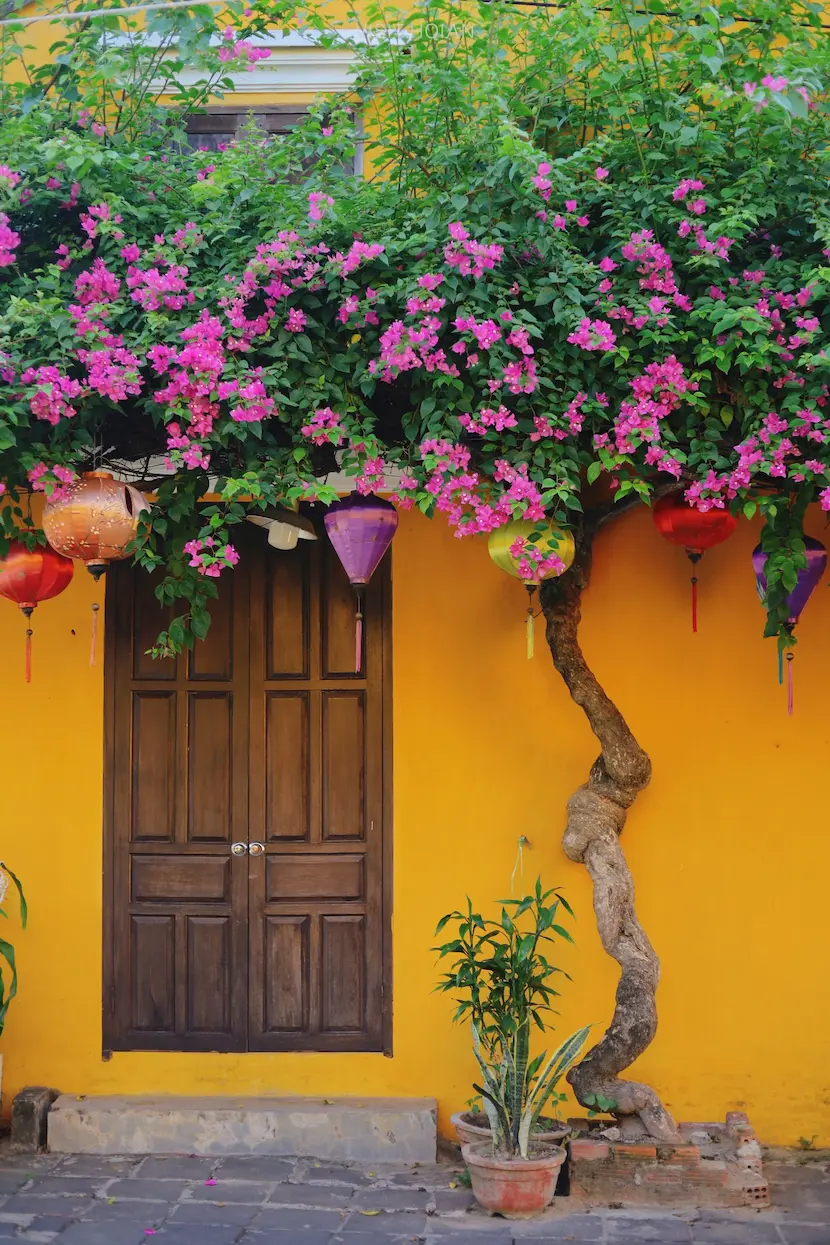
5. Where to stay in Hoi An Ancient Town?
Hoi An is a human-sized city, yet rich in contrasting atmospheres... The city does not lack accommodation, but more than just a bed, as each district offers a different atmosphere, a particular way of experiencing Hoi An. Whether you dream of waking up in the heart of the Ancient Town, a peaceful stay amidst the rice fields, or a few days of relaxation by the sea, the accommodation options in Hoi An cater to all desires and budgets.
Staying right in the Ancient Town
Choosing to stay in the heart of the Ancient Town means settling as close as possible to living heritage. From dawn, the cobblestones gently warm under the footsteps of the first inhabitants, and at dusk, the lanterns light up one by one, like fireflies guiding memory. The ancient houses, sometimes centuries old, now house small hotels with discreet elegance, where every detail recalls Hoi An's mercantile and refined past. Here, you live without a car, to the rhythm of footsteps, scents, and glances.
Learn more: Best places to stay in Hoi An Ancient Town

Staying amidst the green nature
A little further back from the center, in the surrounding countryside, are many accommodations nestled between rice fields or tropical gardens. Here, calm reigns supreme. You fall asleep to the sound of frogs and wake up to a green sea of rice. Hotels and homestays in this area often offer simple but warm decor, a family atmosphere, and bicycles available for exploring the surroundings. It's the perfect choice for travelers seeking serenity, nature, and sincere local encounters.
Staying by the sea
For those who prefer the open air and sunsets on the horizon, An Bang and Cua Dai beaches offer a wide range of accommodations, from beachfront wooden bungalows to five-star resorts with pools and spas. Staying by the sea allows for a different, slower pace, between morning swims, siestas in the shade of coconut trees, and dinners with your feet in the sand. You can easily reach the city center by shuttle, taxi, or bicycle, making it an excellent compromise between relaxation and discovery.
6. How to get to Hoi An Ancient Town?
Hoi An has no airport or train station. And yet, it seems attracted by all paths, like an invisible center of gravity for travelers seeking beauty and slowness. The key is Da Nang, a dynamic neighboring city located about thirty kilometers away, perfectly connected to the rest of Vietnam and major Asian metropolises. Whether you are a fan of comfort, adventure, or contemplation, here are the best ways to reach Hoi An Ancient Town, Vietnam.
By plane
Da Nang International Airport welcomes you with its coastal modernity. It offers numerous daily connections from Hanoi, Ho Chi Minh City, Hue, or Nha Trang, but also from abroad (Bangkok, Singapore, Seoul, Kuala Lumpur...). Once there, you just need to gently glide towards Hoi An, by private car, taxi, or shuttle. The journey takes about 45 minutes, between rice fields and hills, and already gives a taste of the tranquility to come. For more peace of mind, hotels or agencies like IZITOUR offer tailor-made transfers.
By train
The train is a journey within a journey. It will drop you off at Da Nang station, on the main line connecting the north to the south of the country. Whether you come from Hue, Hanoi, or Ho Chi Minh City, the carriages cradle you to the rhythm of the landscapes: green reliefs, rice fields, and views of the East Sea of Vietnam. From the station, a short car or minibus ride takes you to Hoi An, in a soothing contrast between the bustling life of the rails and the provincial gentleness of the ancient city.
By bus
Many bus companies connect Hoi An to the country's main tourist cities. You can reach Hoi An from Hue (3 to 4 hours drive), Nha Trang, Dalat, or even Ho Chi Minh City by night bus. There are also fixed-departure tourist buses, more comfortable than local lines. From Da Nang, shared minibusses provide frequent connections to Hoi An at a low price. It's an economical solution, but it can be less flexible depending on the schedules.
By private car
For families, couples, or travelers looking for flexibility, a private car is ideal. It allows you to adapt the pace, stop wherever you want, and savor the journey as much as the destination. From Da Nang or Hue, you can even make a stop at the Hai Van Pass (Cloud Pass), where mists cling to the mountains and the road winds like a dream.
By motorbike
For adventure seekers, the motorbike ride between Hue and Hoi An is an unforgettable experience. The route crosses the Hai Van Pass, offering spectacular panoramic views of the sea and mountains. Several local agencies offer motorbike rental with luggage transfer, or accompaniment by an experienced driver. An ideal choice for those who want to savor every turn of central Vietnam.

7. Suggested itineraries to discover Hoi An
Whether you have a few hours or several days, Hoi An and its surroundings offer a wide variety of experiences. Here's a selection of itineraries designed to adapt to your pace, your desires... and the unique magic of every moment spent here.
Half-day in Hoi An
If you only have a half day in Hoi An, let's explore of Hoi An's peaceful countryside, excursion to typical craft villages (by Jeep). Check the detailed itinerary and actual price.
One day in Hoi An
Option 1: Visit Hoi An Ancient Town, experience local life at the central market, boat trip on the Thu Bon River
Option 2: Experience Hoi An's countryside by visiting Tra Que and Cam Thanh villages by bike, interact with locals
Option 3: Visit Hoi An Ancient Town, excursion to Tra Que vegetable village
Option 4: Explore Hoi An Old town, boat and bike excursion to traditional craft villages in the countryside
Option 5: Bike ride to Hoi An's craft villages, experience authentic local life and boat trip on the Thu Bon River
Four days in Hoi An
Option 1:
- Day 1: Visit Minh Mang tomb, boat trip on the Perfume River, bike ride to Thuy Bieu village, explore Thien Mu pagoda and Hue citadel
- Day 2: Depart for Hoi An visiting Hai Van Pass and the Cham Sculpture Museum, half-day excursion to Hoi An Ancient Town
- Day 3: Bike ride in Hoi An's countryside villages, boat trip on the Thu Bon River, interact with locals
- Day 4: Visit My Son Sanctuary, contemplate the traditional Champa dance show
Option 2:
- Day 1: Visit Hoi An town, boat and bike excursion to traditional craft villages in the countryside
- Day 2: Visit My Son Sanctuary, contemplate the traditional Champa dance show
- Day 3: Depart for Hue visiting the Cham Sculpture Museum and Hai Van Pass, discover Thien Mu pagoda and Hue citadel
- Day 4: Boat trip on the Perfume River, bike ride in traditional craft villages, visit Khai Dinh tomb
Option 3:
- Day 1: Visit Hoi An town, excursion to Tra Que vegetable village
- Day 2: Visit My Son Sanctuary, contemplate the traditional Champa dance show
- Day 3: Depart for Hue visiting the Cham Sculpture Museum and Hai Van Pass, discover Thien Mu pagoda and Hue citadel
- Day 4: Visit Minh Mang tomb, boat trip on the Perfume River, bike ride to Thuy Bieu village, experience a cooking class
Option 4:
- Day 1: Excursion to Marble Mountain, visit Non Nuoc village and the Cham Museum, discover Son Tra peninsula by exploring Linh Ung pagoda and Ban Co peak
- Day 2: Experience the impressive cable car exploring Ba Na Hills with the magnificent Buddha statue, the Golden Bridge, and Fantasy Park
- Day 3: Discover Hoi An Ancient Town, short excursion to Tra Que vegetable village
- Day 4: Admire Hai Van Pass, discover the ancient capital by visiting Khai Dinh tomb and Hue citadel
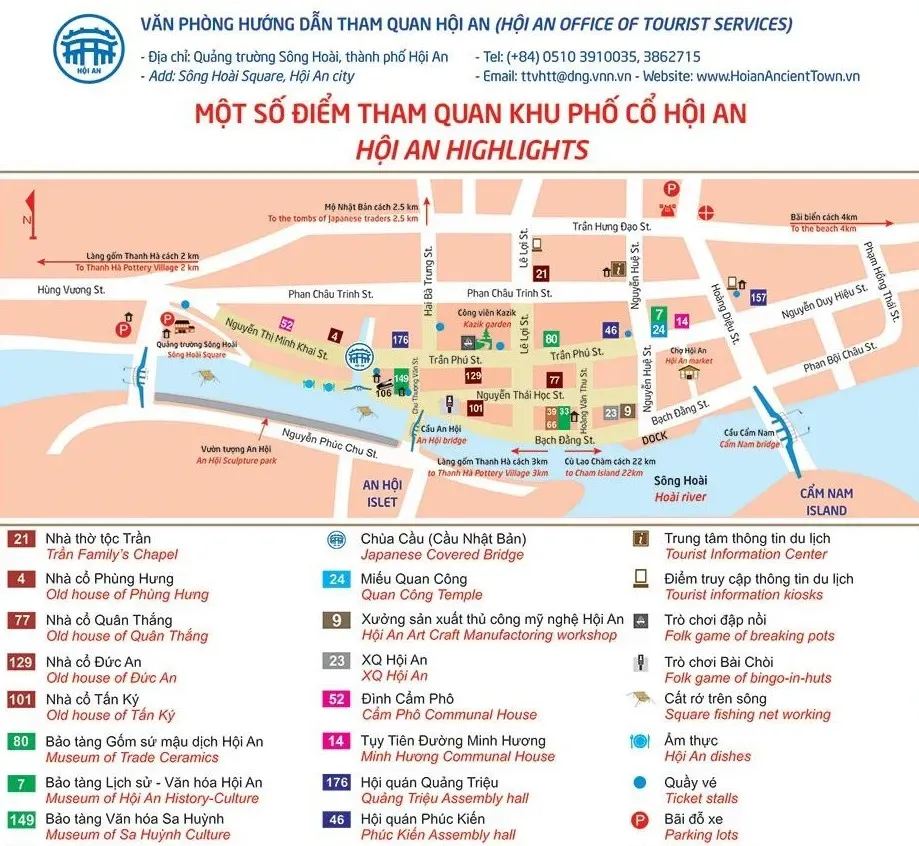
FAQs about Hoi An Vietnam
How many nights should you stay in Hoi An Ancient Town?
If you are in a hurry, one night is enough to get a feel for the city's atmosphere. But to truly enjoy it, two to three nights are most ideal, especially if you wish to explore the countryside, craft villages, or Cu Lao Cham island.
Do you need to buy a ticket to visit the Ancient Town?
Yes. A tourist pass is mandatory to visit the ancient houses, temples, pagodas, and other monuments in the Ancient Town. It is valid for several days and includes 5 entries to major sites.
- Adult: 120,000 VND (approximately $4.62 USD)
- Child (under 16): free
The ticket is valid for several days and includes 5 entries to major sites. You can buy it directly at the entrance of the Ancient Town or through travel agencies.
Where to stay during a combined Da Nang - Hue - Hoi An tour?
The answer depends on the atmosphere you are looking for, and the pace you wish to set for your trip. In practice, many travelers choose to spend one night in Hue to enjoy its unique evening atmosphere, then stay in Hoi An for the rest of the trip, to benefit from its infrastructure, its vibrancy, and its central location. Of course, those who wish for a slower pace can also spend one night in Hue, one in Hoi An, and finish in Da Nang - for a more immersive and varied experience.
Can you rent a motorbike from Hue to Hoi An Ancient Town?
Yes, it is very common. Agencies like Motorvina or Style Motorbikes offer this option with luggage transport included. Average price: 500,000-800,000 VND (18-30 €).
Can you visit Ba Na Hills from Hoi An?
Yes, it's a day trip. The cable car is mandatory and often included in packages (750,000 VND ~ 28.82 USD).
How to get from Hoi An to Phong Nha?
There are direct buses (8 to 10 hours journey). For more comfort, opt for a private driver. Avoid very cheap buses: safety and quality vary greatly.
Traveling to Hoi An Ancient Town is not simply discovering a destination: it's living an inner experience, carried by light, slowness, and discreet gestures. In Hoi An Ancient Town, every stone, every lantern, every smile seems to invite you to slow down, to see differently. You come to see, you return to feel. And long after the journey, the gentleness of its alleys, the inhabited silence of its evenings, and the floating memory of a lantern on the Thu Bon River remain within us. Hoi An Ancient Town never quite closes. It remains lit, somewhere within us.
Do you dream of discovering Hoi An Ancient Town differently, at your own pace, with genuine encounters and local experiences? IZITOUR accompanies you to create a tailor-made trip, blending heritage, nature, and shared emotions. Leave a comment below to share your though with us. Don't forget to contact IZITOUR by email [email protected], our travel advisors are always ready to craft a personalized trip that suit your budget and interests.
Learn more:
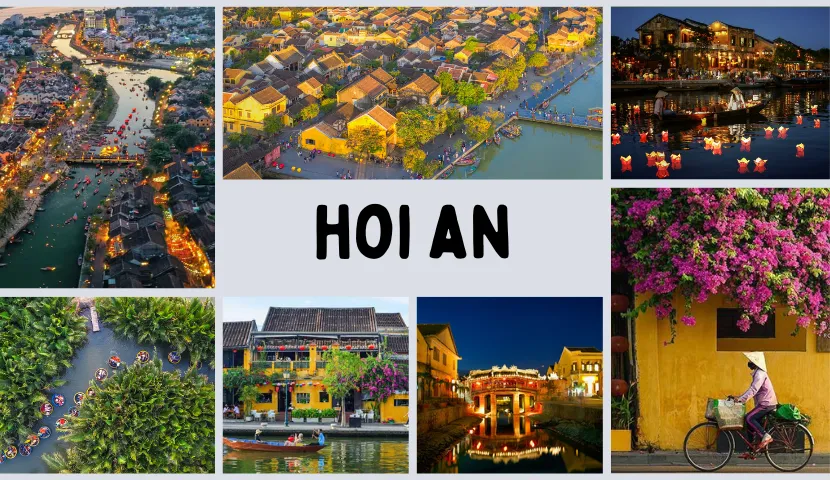








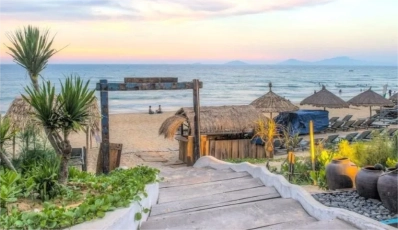





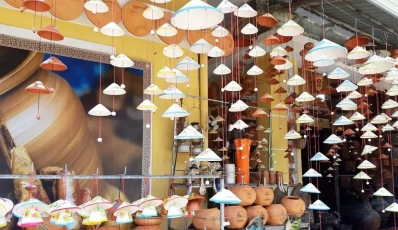


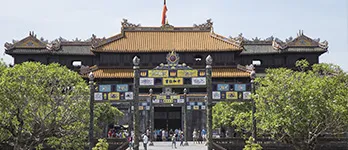


 TRAVELERS' CHOICE 2025
TRAVELERS' CHOICE 2025 